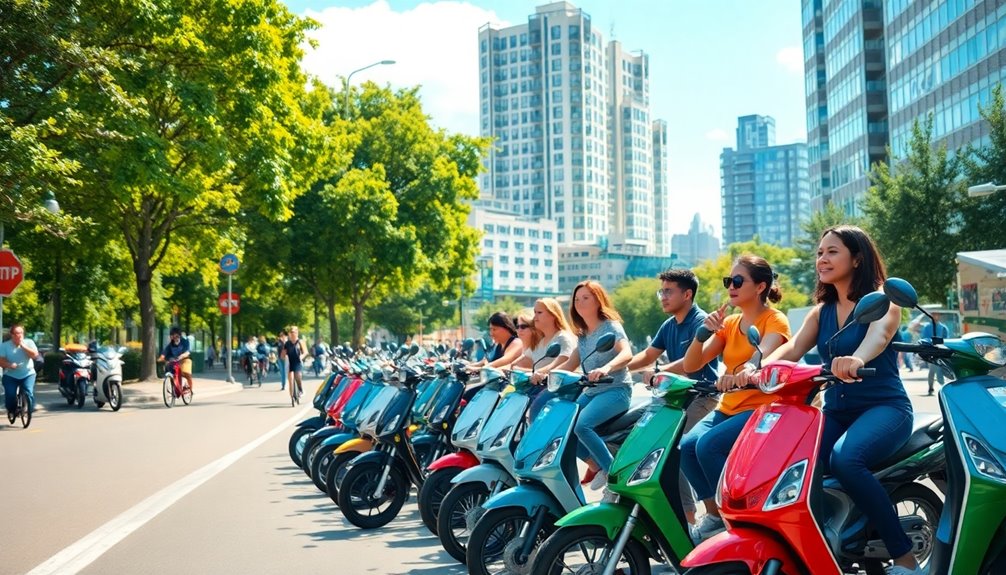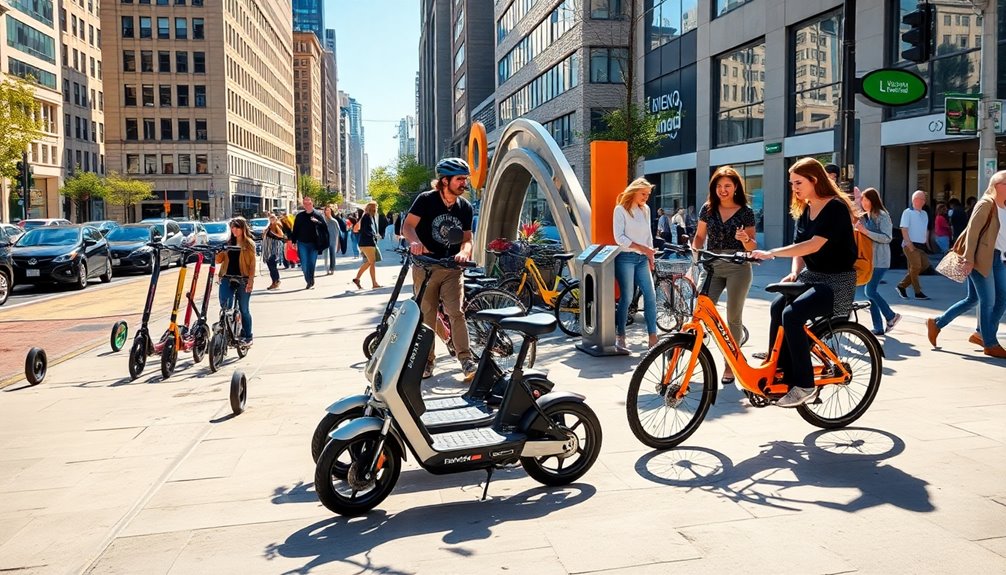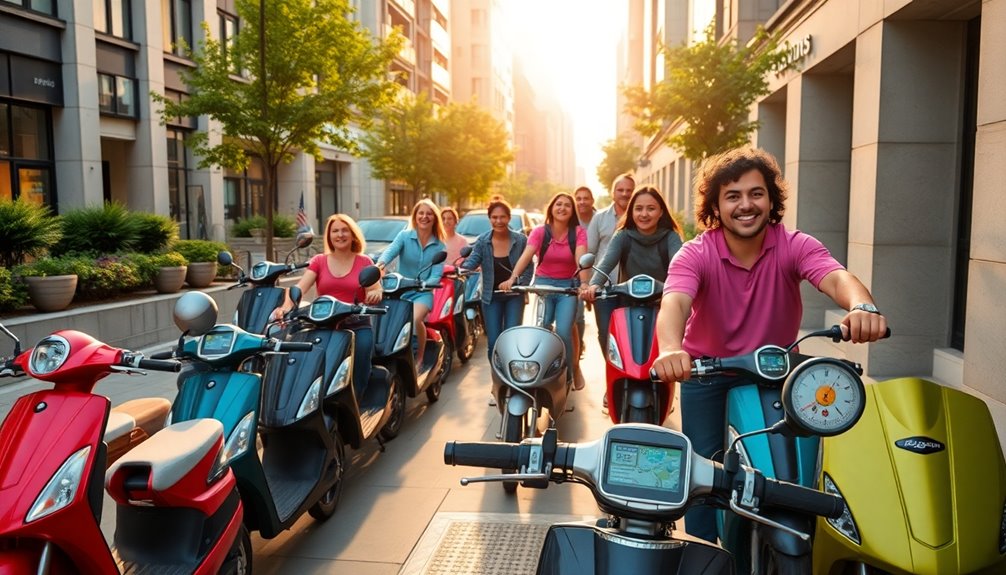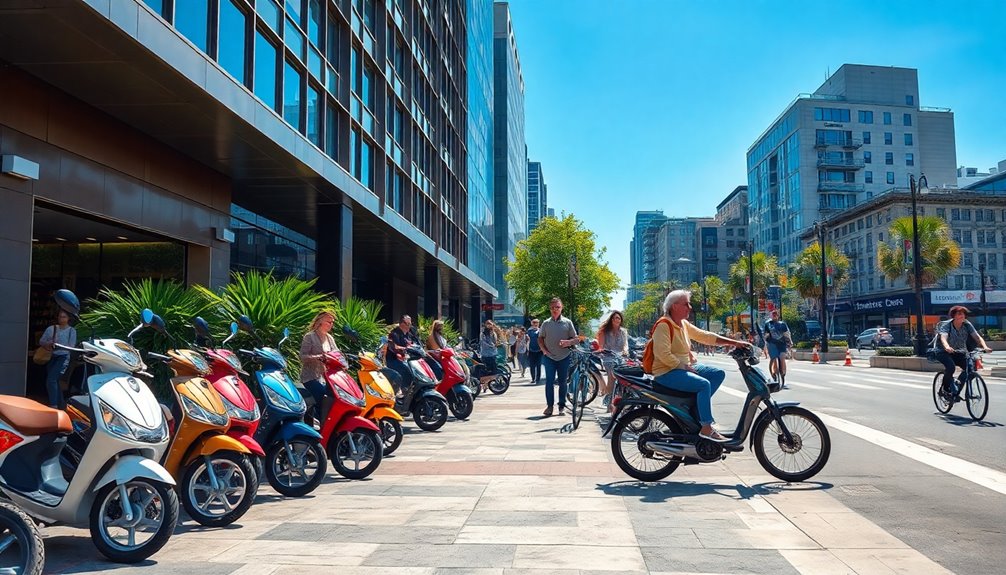The rise of micro-mobility, including electric scooters and bikes, is transforming urban travel. With the market set to soar from $62.98 billion in 2024 to $166.8 billion by 2029, it's driven by urbanization and a push for greener solutions. You'll find that 70% of consumers are eager to adopt these alternatives, and technology is making the experience safer and more convenient. Curious about the trends and innovations shaping this movement? There's much more to discover.
Key Takeaways
- The global micro-mobility market is projected to grow significantly, reaching $327.84 billion by 2033, driven by urbanization and environmental concerns.
- Electric scooters and e-bikes are leading choices for short trips, enhancing convenience and sustainability in urban transportation.
- Adoption of micro-mobility solutions is increasing, with 70% of consumers willing to use them, especially post-pandemic.
- Technological advancements like IoT and 5G are enhancing safety, monitoring, and user experience in micro-mobility services.
- Micro-mobility options contribute to improved air quality and reduced traffic congestion, promoting healthier urban living.
Market Growth and Projections

The global micro-mobility market is set for remarkable growth, projected to climb from $62.98 billion in 2024 to $75.85 billion in 2025, reflecting a robust CAGR of 20.4%.
The global micro-mobility market is poised for significant growth, expected to reach $75.85 billion in 2025 with a 20.4% CAGR.
By 2029, you can expect the market to reach $166.8 billion, with an impressive CAGR of 21.8%.
Over the next decade, the market is projected to soar to $204.83 billion by 2033, ultimately hitting $327.84 billion, growing at a CAGR of 17.45%.
This expansion is fueled by increasing demand for public transportation, rapid urbanization, and environmental concerns.
As shared mobility services gain traction and battery technology advances, consumer preferences will continue to shift toward sustainable options, driving this vibrant market growth.
Types of Micromobility Vehicles

Micromobility vehicles come in various forms, each designed to meet specific transportation needs and preferences.
Electric scooters are popular for short trips, often found in shared systems like Bird and Lime. Electric bicycles, or e-bikes, range from pedal-assist models to throttle-assist options, catering to different riding styles.
Skateboards and hoverboards offer lightweight, personal transport solutions, while Segways and unicycles provide unique alternatives. For those needing to carry goods, cargo e-bikes are ideal. Additionally, multiple passenger e-bikes can accommodate more riders.
Overall, these micromobility options emphasize convenience, sustainability, and efficiency, transforming urban travel while fitting seamlessly into bike lanes and sidewalks. They can also serve as a retirement savings option for individuals looking to reduce commuting costs and invest in long-term financial health.
With speeds typically capped at 20 MPH or less, they ensure safe navigation in busy environments.
Adoption and Usage Trends

As urbanization accelerates and traffic congestion rises, more people are turning to micromobility solutions for their daily commutes.
The global micromobility market is set to reach $260 billion by 2025, with Europe and North America each contributing around $60 billion.
The global micromobility market is projected to hit $260 billion by 2025, with Europe and North America each contributing approximately $60 billion.
About 70% of consumers express a willingness to adopt these options, continuing a post-pandemic trend.
E-scooters are rapidly gaining traction in U.S. cities, competing strongly with bikesharing services.
Additionally, the emphasis on health and fitness drives the popularity of bicycles and e-bikes.
With private ownership of these vehicles expected to double by 2025, it's clear that micromobility is becoming an essential part of urban transportation, enhancing convenience and sustainability in daily travel.
Technological Advancements

With the growing adoption of micromobility solutions, technological advancements are transforming how these vehicles operate and enhance user experiences.
You'll find IoT sensors and AI integrated into devices, providing real-time data and predictive maintenance for a smoother ride. The rollout of 5G technology allows for real-time fleet monitoring, advanced safety features, and quicker communication.
Mobile apps simplify your access and payment, while smart navigation helps you choose the safest routes. Enhanced safety features, like AI cameras and collision detection, significantly reduce accidents.
Ergonomically designed vehicles make your ride more comfortable, and eco-friendly materials contribute to sustainability.
Together, these innovations create a seamless, efficient, and enjoyable micromobility experience, positioning it as a vital component of urban transport.
Economic and Environmental Impact

While urban areas grapple with congestion and pollution, the rise of micro-mobility solutions offers a promising economic and environmental alternative.
You'll notice that the micro-mobility market is projected to grow significantly, reaching USD 6.1 billion by 2027. This growth creates jobs, with approximately 9,000 positions linked to shared micromobility.
Economically, e-scooters boost local spending, increasing restaurant revenues by about 4.4%.
E-scooters enhance local economies, driving restaurant revenues up by approximately 4.4%.
Environmentally, these options emit zero emissions and improve air quality, making them a sustainable choice for short trips.
By encouraging modal shifts and reducing reliance on cars, micro-mobility not only alleviates traffic congestion but also fosters healthier urban living.
Embracing these solutions can lead to a greener, more efficient city for everyone.
Frequently Asked Questions
What Safety Measures Are in Place for Micromobility Users?
To ensure your safety while using micromobility devices, several measures are in place.
You'll find dedicated lanes and protected routes designed to keep you separated from motor vehicles.
Always wear a helmet and follow responsible riding practices.
Regularly check your device for any damage, and use approved chargers to prevent fire hazards.
Local regulations also help by enforcing speed limits and promoting safe behaviors among riders, enhancing overall safety for everyone on the road.
How Do Weather Conditions Affect Micromobility Usage?
Weather conditions can significantly impact your micromobility choices. If it's raining, cold, or windy, you might find yourself opting for e-scooters over bikes or e-bikes, as they're less affected by the elements.
Extreme heat or high humidity can also deter you from riding. You might appreciate having weather alerts to plan your trips better, especially since user tolerance for discomfort varies, influencing your decision on which mode to use.
Are There Age Restrictions for Using Micromobility Vehicles?
You might think anyone can hop on a micromobility vehicle, but that's not the case. Many places enforce age restrictions, often requiring riders to be at least 16 years old.
Some cities, like Los Angeles, even set the minimum age at 18. Additionally, helmet laws vary, with younger users typically needing to wear one.
These regulations aim to ensure safety while navigating the challenges of enforcement and accessibility for younger riders.
What Maintenance Is Required for Personal Micromobility Vehicles?
For personal micromobility vehicles, you'll need to perform regular maintenance to keep them in top shape.
Check the brakes, tires, and lights frequently to ensure everything's functioning correctly.
It's also wise to inspect for wear and tear and any signs of vandalism.
If you notice any issues, address them promptly.
Keeping a maintenance log can help track repairs and ensure your vehicle remains safe and reliable for your rides.
How Can Cities Improve Micromobility Infrastructure?
Imagine whizzing through your city, but suddenly, a pothole threatens your ride.
To improve micromobility infrastructure, cities need to create protected bike lanes, reduce vehicle speeds, and incorporate mixed-use developments.
You'll feel safer navigating streets designed with your needs in mind.
Conclusion
As you explore the rise of micro-mobility, you'll find it's more than just a trend; it's a shift in how we navigate urban spaces. The theory that these vehicles can reduce congestion and emissions holds true, making cities more livable. By embracing scooters and bikes, you're not only enjoying a convenient ride but also contributing to a sustainable future. So, hop on and experience the freedom of micro-mobility—it's a movement that's here to stay!









